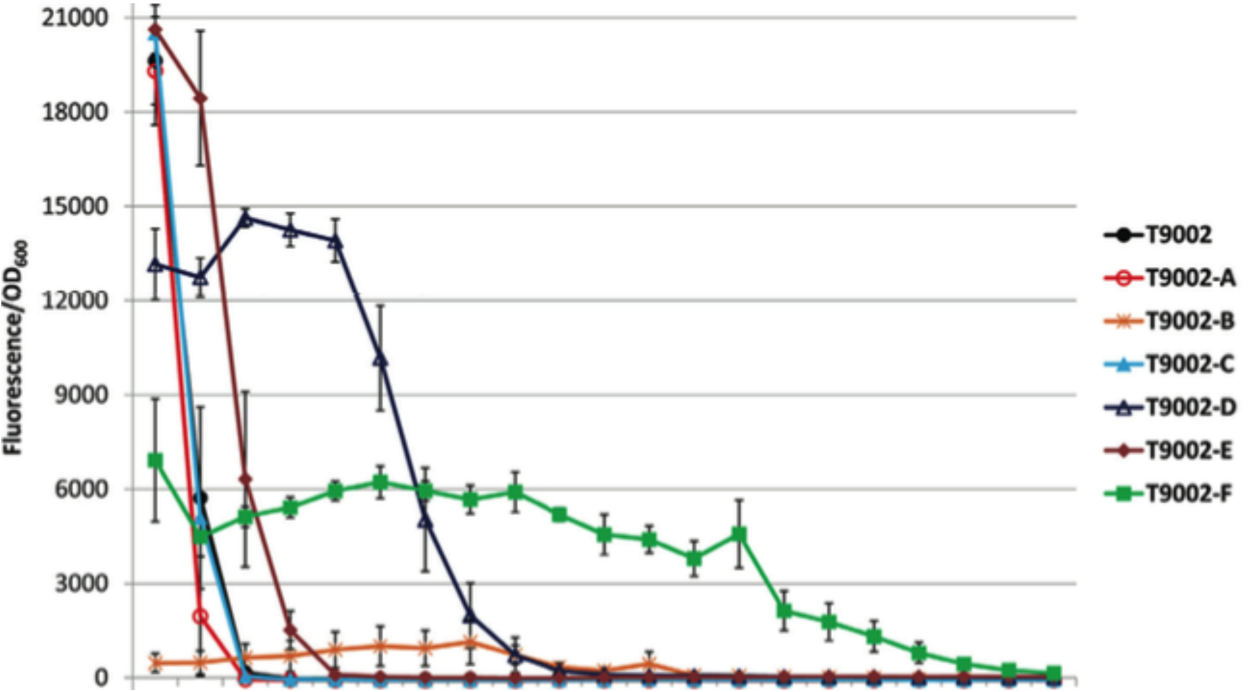Difference between revisions of "Team:Austin UTexas/Project/Problem"
Kvasudevan (Talk | contribs) |
|||
| Line 5: | Line 5: | ||
[[Image:2015_Austin_UTexas_sleightpaperfig.png|300px|thumb|left|Evolutionary stability of T9002 (black) and T9002 (color) re-engineered circuits with AHL - Image credit to Sean C. Sleight <i>et al.</i>]] | [[Image:2015_Austin_UTexas_sleightpaperfig.png|300px|thumb|left|Evolutionary stability of T9002 (black) and T9002 (color) re-engineered circuits with AHL - Image credit to Sean C. Sleight <i>et al.</i>]] | ||
| − | One of the major issue facing genetic engineering is the overall longevity of genetic devices once inserted into organisms. An organism can be modified, but that does not ensure that the modification will last. <b>Subsequent generations of modified organisms often lose or “break” the genetic device through mutations.</b> | + | One of the major issue facing genetic engineering is the overall longevity of genetic devices once inserted into organisms. An organism can be modified, but that does not ensure that the modification will last. <b>Subsequent generations of modified organisms often lose or “break” the genetic device through mutations.</b> Breaking a plasmid or an inserted device decrease the metabolic load of that organism giving it a competitive advantage by allocating cell resources for other tasks. This allows them to dominate a population over some time. |
| + | |||
| + | Previous research has determined several factors that contribute to the breaking of genetic devices, among them being the relative fitness of organisms without the device over those with it. Strongly expressed devices will break faster than less strongly expressed devices, since they have a greater metabolic load on the organism. Similarly, genes that code for large, 'costly' proteins are more likely to break. | ||
| + | |||
| + | Another major factor that contributes to device stability is the presence of sequence repeats. The <a href="http://barricklab.org/django/efm/">Evolutionary Failure Mode calculator</a> developed by the Barrick lab identifies DNA sequences that are prone to breaking, such as simple sequence repeats and long sequences of a single nucleotide. Sequences entered into the EFM calculator are given a relative instability prediction (RIP) score based on these mutation hot-spots that determines how 'at-risk' a device's stability is. If a particular sequence contains many short sequence repeats or even large, similar regions, then that sequence risks mutating in later generations. | ||
=== Project and Motivation === | === Project and Motivation === | ||
Revision as of 20:04, 18 September 2015
Problem: Genetic Instability
Background
One of the major issue facing genetic engineering is the overall longevity of genetic devices once inserted into organisms. An organism can be modified, but that does not ensure that the modification will last. Subsequent generations of modified organisms often lose or “break” the genetic device through mutations. Breaking a plasmid or an inserted device decrease the metabolic load of that organism giving it a competitive advantage by allocating cell resources for other tasks. This allows them to dominate a population over some time.
Previous research has determined several factors that contribute to the breaking of genetic devices, among them being the relative fitness of organisms without the device over those with it. Strongly expressed devices will break faster than less strongly expressed devices, since they have a greater metabolic load on the organism. Similarly, genes that code for large, 'costly' proteins are more likely to break.
Another major factor that contributes to device stability is the presence of sequence repeats. The <a href="http://barricklab.org/django/efm/">Evolutionary Failure Mode calculator</a> developed by the Barrick lab identifies DNA sequences that are prone to breaking, such as simple sequence repeats and long sequences of a single nucleotide. Sequences entered into the EFM calculator are given a relative instability prediction (RIP) score based on these mutation hot-spots that determines how 'at-risk' a device's stability is. If a particular sequence contains many short sequence repeats or even large, similar regions, then that sequence risks mutating in later generations.
Project and Motivation
The stability of the sequence is the focus of our research over the course of the summer. We wish to identify and better characterize sequences that contribute to the relative instability of genetic devices so they can be used to predict device longevity, as well as be taken into account when creating and modifying such devices. In the spring of 2015, UT iGEM team members utilized the Evolutionary Failure Mode (EFM) calculator designed by the Barrick lab to identify sequences within fluorescent protein coding genes that were more likely to break, or mutate. The EFM calculator identifies repeat-mediated deletion sites (characterized by long chains of the same base that makes it easier for replication errors) and simple sequence repeat sites in sequences where mutations are more likely to happen, and gives a relative instability prediction (RIP) score. Higher RIP scores indicate more sequences where the gene is likely to break, and we used this information to form hypotheses and determine which fluorescent protein coding genes in our inventories are the most and least evolutionary stable.
Over the summer, these three plasmids were used to transform four strains of bacteria (Top-10, MDS-42, BL-21 (DE3), BW-25113). Growing these transformed strains in culture and monitoring their fluorescence and stability will hopefully elucidate more regarding patterns in the sequences that contribute to the instability of genetic devices. Understanding this could lead to more stable devices and thus could increase the longevity of genetically modified organisms.
